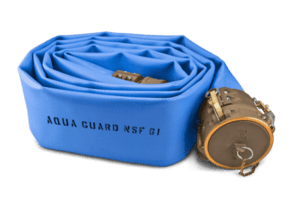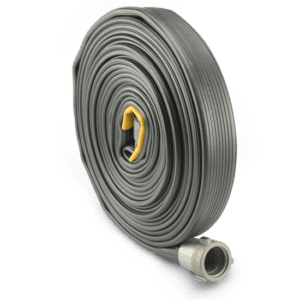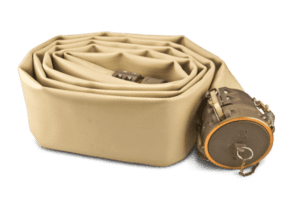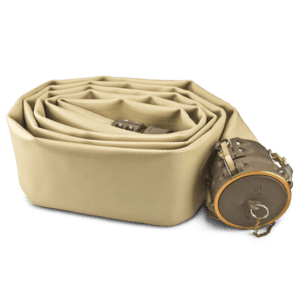Our Industrial lay flat hoses are designed for a wide variety of applications, with long lasting durability and are heavily reinforced with exceptional resistance to abrasion and cutting.
Home
Lay Flat Hose
Industrial
Industrial Lay Flat Hose
In 50-Ft (15m) and 100-Ft (30m) Sections
Aqua Guard
 Introducing Aqua Guard: a premium solution engineered for the reliable transfer of potable water across expansive distances, making it ideal for remote locations, new developments, and temporary water distribution systems. This Mil-Spec, large-diameter hose is NSF61-certified, ensuring the highest standards of safety for drinking water applications. Its innovative through-the-weave one-piece construction integrates a circular woven high-tenacity polyester reinforcement, fully encapsulated within a robust elastomeric polyurethane cover and lining. This design guarantees exceptional durability and maintenance-free operation, even in the most demanding environments.
Introducing Aqua Guard: a premium solution engineered for the reliable transfer of potable water across expansive distances, making it ideal for remote locations, new developments, and temporary water distribution systems. This Mil-Spec, large-diameter hose is NSF61-certified, ensuring the highest standards of safety for drinking water applications. Its innovative through-the-weave one-piece construction integrates a circular woven high-tenacity polyester reinforcement, fully encapsulated within a robust elastomeric polyurethane cover and lining. This design guarantees exceptional durability and maintenance-free operation, even in the most demanding environments.
Armour Guard
 Armour Guard® stands as a premier choice in lay-flat, flexible water-discharge hoses, delivering exceptional performance in oil field operations. Engineered with a unique nitrile/PVC blend, it combines lightweight and compact characteristics with superior durability and abrasion resistance compared to traditional rubber hoses.
Armour Guard® stands as a premier choice in lay-flat, flexible water-discharge hoses, delivering exceptional performance in oil field operations. Engineered with a unique nitrile/PVC blend, it combines lightweight and compact characteristics with superior durability and abrasion resistance compared to traditional rubber hoses.
Fuel Hose
 Introducing the ultimate solution for all your fuel transfer requirements: Anaconda Fuel Hose. Engineered as a top-tier lay-flat hose specifically for fuel transfer, Anaconda Fuel Hose boasts a robust through-the-weave construction. Its core features a high-tenacity polyester reinforcement, seamlessly integrated into a durable elastomeric polyurethane cover and lining. This design ensures unparalleled protection and longevity, capable of withstanding the most demanding conditions without maintenance.
Introducing the ultimate solution for all your fuel transfer requirements: Anaconda Fuel Hose. Engineered as a top-tier lay-flat hose specifically for fuel transfer, Anaconda Fuel Hose boasts a robust through-the-weave construction. Its core features a high-tenacity polyester reinforcement, seamlessly integrated into a durable elastomeric polyurethane cover and lining. This design ensures unparalleled protection and longevity, capable of withstanding the most demanding conditions without maintenance.
WAT-Hog
 Introducing WAT-Hog, an advanced large-diameter hose engineered for the reliable transfer of fuel, wastewater, as well as treated and reclaimed water. This premium lay-flat hose is designed with a through-the-weave, one-piece construction featuring a robust circular woven high-tenacity polyester reinforcement fully encapsulated within a rugged cover and lining. The hose’s inner lining, crafted from durable elastomeric polyurethane, ensures resilience and longevity in challenging operational conditions.
Introducing WAT-Hog, an advanced large-diameter hose engineered for the reliable transfer of fuel, wastewater, as well as treated and reclaimed water. This premium lay-flat hose is designed with a through-the-weave, one-piece construction featuring a robust circular woven high-tenacity polyester reinforcement fully encapsulated within a rugged cover and lining. The hose’s inner lining, crafted from durable elastomeric polyurethane, ensures resilience and longevity in challenging operational conditions.
Get Industrial Lay Flat Pricing Now!
Call us now or fill out our request form for a prompt estimate.
Lay Flat Hose Rentals
Many Anaconda customers use our HDPE pipe solutions for temporary or short term projects. We offer the flexibility of renting our pipe and hose solutions to ensure that once a project is complete, the equipment can be returned with relative ease. Please contact us for details.
- Compact Storage: One of the primary advantages of lay-flat hoses is their ability to be stored compactly. These hoses can be rolled up or folded flat when not pressurized, minimizing storage space requirements. This feature is particularly beneficial in industries where space optimization is crucial.
- Easy Handling and Deployment: Lay flat hoses are lightweight and easy to handle, making them convenient for quick deployment in various industrial settings. Their flexibility allows for straightforward maneuverability, reducing the time and effort required for installation and repositioning.
- Quick Setup and Retrieval: The flat design of these hoses facilitates rapid deployment and retrieval. This is especially advantageous in emergencies or applications where time efficiency is critical, such as firefighting, irrigation, or temporary fluid transfer operations.
- Reduced Risk of Kinking and Tangling: Traditional hoses can be prone to kinking and tangling, which can impede fluid flow and lead to inefficiencies. Lay flat hoses, with their flat design, are less susceptible to kinking and tangling, ensuring a smooth and uninterrupted fluid transfer process.
- High Flow Capacity: Lay flat hoses are engineered to have a larger internal diameter than other types of hoses. This design feature contributes to high flow capacity, enabling the efficient transfer of liquids, slurries, or chemicals in industrial applications where a substantial fluid volume needs to be moved.
- Durability and Longevity: These hoses are typically constructed from robust materials such as synthetic nitrile rubber or PVC, which makes them resistant to abrasion, chemicals, and UV exposure. This durability ensures a longer operational lifespan, reducing the frequency of replacements and maintenance costs.
- Versatility in Applications: Lay flat hoses find applications in various industrial sectors, including agriculture, construction, mining, oil and gas, and firefighting. Their adaptability to different fluids and environments makes them versatile for various fluid transfer needs.
- Cost-Effective Solution: The durability, ease of handling, and efficient fluid transfer capabilities of lay flat hoses contribute to a cost-effective solution for many industrial applications. Reducing labor time, maintenance, and the need for additional equipment makes them an economical choice for fluid conveyance.
In summary, lay-flat hoses offer a practical and efficient solution for industrial fluid transfer needs. They combine ease of use, versatility, and cost-effectiveness. Their unique design and advantageous features make them a preferred choice in numerous industrial settings.
Frequently Asked Questions
Welcome to our Lay Flat Hose FAQ section. Here, we address common queries about our high-quality industrial lay flat hoses which are designed for robust service in various applications. If you have additional questions, feel free to contact our experts for personalized assistance.
What is an industrial lay flat hose?
Answer: An industrial lay flat hose is a flexible, collapsible hose designed for efficient fluid transfer. Its flat design allows for easy storage and transport when not in use.
What materials are lay flat hoses made from?
Answer: Lay flat hoses are commonly made from PVC, polyurethane, or nitrile rubber. Material choice depends on factors like chemical compatibility, flexibility, and durability.
How do lay flat hoses differ from traditional hoses?
Answer: Lay flat hoses distinguish themselves by their flat, collapsible design, making them easy to store. They are typically lightweight and flexible, suitable for temporary or portable fluid transfer.
What are the most critical advantages of lay flat hoses?
Answer: Lay flat hoses offer benefits such as ease of handling, quick deployment, kink resistance, and the ability to cover large areas. They are also cost-effective and easy to transport.
Can lay flat hoses handle high-pressure applications?
Answer: Lay flat hoses are generally designed for low to medium-pressure applications. Specialized versions with reinforced layers may handle higher pressures, but choosing the right type for the application is crucial.
Can lay flat hoses handle abrasive materials?
Answer: Lay flat hoses can handle some abrasion, but using reinforced industrial hoses with specialized abrasion-resistant materials is recommended for abrasive applications.
What considerations are important when selecting lay flat hoses?
Answer: Consider factors like material compatibility, pressure requirements, temperature range, flexibility, and abrasion resistance. Choose hoses that meet industry standards and are suitable for the specific application.
Are lay flat hoses suitable for potable water applications?
Answer: Yes, lay flat hoses made from materials approved for potable water use are available. Always check the hose specifications and certifications to ensure compliance with drinking water standards.
How do I determine the right size of lay flat hose for my application?
Answer: Consider the required flow rate, pressure, and the distance the hose must cover. Consult manufacturer specifications and charts to choose the appropriate diameter and length for optimal performance.
How do I determine the right size of lay flat hose for my application?
Answer: Consider the required flow rate, pressure, and the distance the hose must cover. Consult manufacturer specifications and charts to choose the appropriate diameter and length for optimal performance.
What maintenance is required for industrial suction hoses?
Answer: Regular inspection for wear, damage, or deterioration is essential. Proper storage away from sunlight and chemicals, along with correct fittings and couplings, contributes to longevity.
Are lay flat hoses suitable for transferring chemicals?
Answer: Depending on the material composition, lay flat hoses can be suitable for chemical transfer. Verifying chemical compatibility and choosing hoses designed for chemical applications is essential.
How do you store and maintain lay flat hoses?
Answer: Store hoses flat, away from direct sunlight and extreme temperatures. Regularly inspect for abrasions, punctures, or kinks. Clean hoses after use and follow manufacturer guidelines for maintenance.


